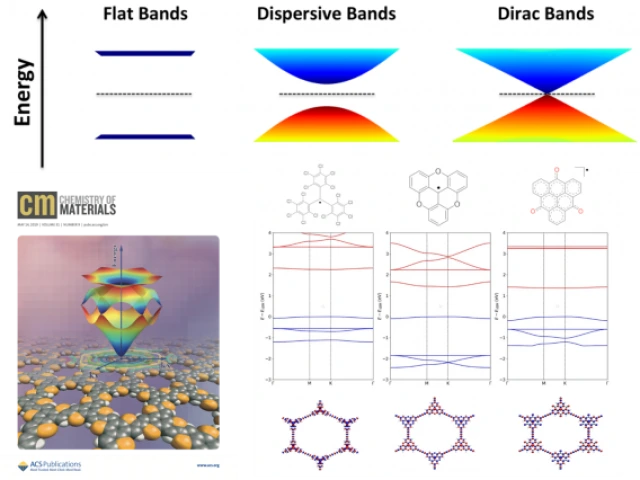Two-dimensional (2D) covalent organic frameworks (COFs) are a class of porous materials in which monomer cores and linkers organize to form well-defined periodic structures via covalent bonds. The topology derives from the directionality of the covalent linkages, which offers a means to organize chemical functionality with atomic precision over long distances. The vast structural diversity of organic π-conjugated moieties provides great opportunities in terms of designing and tailoring novel properties in 2D polymer networks. These emerging materials show great promise for applications including optoelectronics, spintronics, molecular recognition and sensing, catalysis, or membranes.
Using an integrated theoretical approach including kinetic Monte Carlo (KMC) and molecular dynamics (MD) simulations, density functional theory (DFT) calculations, and tight-binding (TB) modeling, we seek to gain an understanding of: (i) the electronic, optical, and magnetic properties of 2D COFs, both in the form of isolated monolayers or few-layers and when they interact with metal, graphene, or semiconductor surfaces; and (ii) their growth mechanism. In particular, we focus on:

COF structure
(i) Developing a comprehensive understanding of the relationships among chemical structures, geometric structures, and electronic structures of 2D COFs, in order to design novel 2D COF-based materials with tunable electrical, magnetic, and non-trivial topological properties (such as quantum anomalous Hall and quantum spin Hall effects). These include a broad range of materials, such as radical-carrying COFs, p- or n-type doped COFs, and interfaces formed between COFs and various semiconducting substrates including transition metal dichalcogenides.

COF growth
(ii) Describing the microscopic process involved in the growth of COFs. In order to understand the chemical processes that lead to COF polymerization and crystallization, we use KMC simulations to investigate the dynamics of 2D COF formation from solution. Our KMC model has successfully reproduced the key features of the experimentally determined kinetic curve of COF-5 growth and accurately predicted the dependencies of the nucleation and growth rates on monomer concentration.
Recent publications:
-
Huifang Li, Hong Li, Sangni Xun, Jean-Luc Bredas, "Doping modulation of the charge injection barrier between a covalent organic framework monolayer and graphene", Chem. Mater. ASAP, 2020.
-
H. Y. Li; A. M. Evans; I. Castano; M. J. Strauss; W. R. Dichtel; J.-L. Bredas, "Nucleation–Elongation Dynamics of Two-Dimensional Covalent Organic Frameworks", Journal of the American Chemical Society, 142, 1367 (2020).
-
D. J. Rizzo; Q. Dai; C. Bronner; G. Veber; B. J. Smith; M. Matsumoto; S. Thomas; G. D. Nguyen; P. R. Forrester; W. Zhao; J. H. Jørgensen; W. R. Dichtel; F. R. Fischer; H. Li; J.-L. Bredas; M. F. Crommie, "Revealing the Local Electronic Structure of a Single-Layer Covalent Organic Framework through Electronic Decoupling", Nano Letters, 20, 963 (2020).
-
S. Jhulki; A. M. Evans; X.-L. Hao; M. W. Cooper; C. H. Feriante; J. Leisen; H. Li; D. Lam; M. C. Hersam; S. Barlow; J.-L. Brédas; W. R. Dichtel; S. R. Marder, "Humidity Sensing through Reversible Isomerization of a Covalent Organic Framework", Journal of the American Chemical Society, 142, 783 (2020).
-
T. Joshi; C. Chen; H. Li; C. S. Diercks; G. Wang; P. J. Waller; H. Li; J.-L. Bredas; O. M. Yaghi; M. F. Crommie, "Local Electronic Structure of Molecular Heterojunctions in a Single-Layer 2D Covalent Organic Framework", Advanced Materials, 31, 1805941 (2019).
-
I. Castano; A. M. Evans; H. Li; E. Vitaku; M. J. Strauss; J.-L. Brédas; N. C. Gianneschi; W. R. Dichtel, "Chemical Control over Nucleation and Anisotropic Growth of Two-Dimensional Covalent Organic Frameworks", ACS Central Science, 5, 1892 (2019).
-
S. Thomas; H. Li; C. Zhong; M. Matsumoto; W. R. Dichtel; J.-L. Bredas, "Electronic Structure of Two-Dimensional π-Conjugated Covalent Organic Frameworks", Chemistry of Materials, 31, 3051 (2019).
-
S. Thomas; H. Li; J.-L. Bredas, "Emergence of an Antiferromagnetic Mott Insulating Phase in Hexagonal π-Conjugated Covalent Organic Frameworks", Advanced Materials, 31, 1900355 (2019).
-
S. Thomas; H. Li; R. R. Dasari; A. M. Evans; I. Castano; T. G. Allen; O. G. Reid; G. Rumbles; W. R. Dichtel; N. C. Gianneschi; S. R. Marder; V. Coropceanu; J.-L. Brédas, "Design and synthesis of two-dimensional covalent organic frameworks with four-arm cores: prediction of remarkable ambipolar charge-transport properties", Materials Horizons, 6, 1868 (2019).
-
H. Y. Li; J.-L. Brédas, "Nanoscrolls Formed from Two-Dimensional Covalent Organic Frameworks", Chemistry of Materials, 31, 3265 (2019).
-
C. Chen; T. Joshi; H. F. Li; A. D. Chavez; Z. Pedramrazi; P.-N. Liu; H. Li; W. R. Dichtel; J.-L. Brédas; M. F. Crommie, "Local Electronic Structure of a Single-Layer Porphyrin-Containing Covalent Organic Framework", ACS Nano, 12, 385 (2018).
-
H. Y. Li; J.-L. Brédas, "Large Out-of-Plane Deformations of Two-Dimensional Covalent Organic Framework (COF) Sheets", The Journal of Physical Chemistry Letters, 9, 4215 (2018).
-
H. Y. Li; A. D. Chavez; H. F. Li; H. Li; W. R. Dichtel; J.-L. Brédas, "Nucleation and Growth of Covalent Organic Frameworks from Solution: The Example of COF-5", Journal of the American Chemical Society, 139, 16310 (2017).

